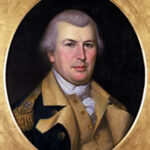No man is an Island. No scientist is an island. No matter how smart a person may be, no matter how in depth his studies may be, one person cannot do everything himself. No one scientist can be the master of all disciplines and do the all the required research in different fields to prove a paradigm. Thomas Kuhn describes in The Structure of Scientific Revolution just how scientific research is conducted and what is required for scientific advancement.
The scientific community is affected by multiple forces. Research is conducted to support or disprove theories within the scientific community. Also, outside sociological aspects affect the scientific community. Political environment, philosophical theories, and philanthropy all effect the output of the scientific society. Would the scientific world have disproved the theory that the world was flat if it wasn’t for the discovery of the new world? Would Newton have developed the theory of attraction and gravity if it wasn’t for the scientific community and the general public asking questions about planetary rotations?
Professor Kuhn investigates how scientific theories are developed. How these theories are then researched and developed and proven. He also discusses what happens to theories that have been disregarded and rejected. Professor Kuhn describes how a scientific revolution starts a new series of scientific investigation and disposes of the old outdated paradigms.
As a Marxist and a post-modernist, Professor Kuhn has created a stir in the religious community. His belief that about truth that comes from around us and is dictated from society is eminent through out his book. Dean Geuras quotes Stan Grenz on what the postmodernism view is:
“[Postmodernism} affirms that whatever we accept as truth and even the way we envision truth are dependent on the community in which we participate….There is no absolute truth; rather truth is relative to the community in which we participate.” (Geuras)
Truth is dictated by the community for which we participate and that which we serve. For example, in modern day the act of cannibalism is one of the great taboo crimes against humanity. The very act of desecrated the human remains by eating it is written explicitly against in the Bible and Koran. Hence forth, it has been considered the act of heathens and been a basic more and law in all societies. However, this wasn’t always the case, Indigenous tribes in Brazil, Louisiana (such as the Nez Perez) and New Zealand all practiced cannibalism. These tribes thought it was respectful and a rite of passage if you consumed the body of a deceased member of the tribe. So was it wrong for these tribes to practice cannibalism? By the laws and religion of their tribes that dictated their acts, no. Henceforth there was no absolute truth dictated by the Biblical God to them. If there were, it was different than the law dictated to the Christians. Their law and rituals were dictated by the society that they served, hence a postmodern view.
Thomas Kuhn show the readers how science has moved throughout the ages based on the laws of society. Science has acted on the popular beliefs of the day. Sometimes science has acted against them only to be faced with a violent reaction. If there were such a thing as absolute truth as dictated by God, then what good would science do? The process of discovery would be a moot point since everything is already true. At no time would man be required or want to discover the unknown. God would expose to his disciples the absolute truth that he desires them to know. At no time would modern science progress, and science and human knowledge would die.
The parallelism between scientific discovery and the political world is uncanny and creates a sense of question to the reader of Mr. Kuhn.
“Political revolutions are inaugurated by a growing sense, often restricted to a segment of the political community, that existing institutions have ceased adequately to meet the problems posed by an environment that they have in part creates. In much the same way, scientific revolutions are inaugurated by a growing sense, again often restricted to a narrow subdivision of the scientific community, that an existing paradigm has ceased to function adequately in the exploration of an aspect of nature to which that paradigm itself had previously led the way.” (Kuhn)
As the reader can see, the parallel between the scientific world of discovery and the political world is very similar. Much the same way that political revolutions have occurred in many countries based on desired changes and observations conducted by the general public, scientists have had scientific revolutions based on observations that they have conducted. It isn’t until these scientific discoveries through phenomenon that revolutions occur and a paradigm shift occurs.
Professor Kuhn comments in the postscript of The Structure of Scientific Revolution about the parallelism of scientific discovery and other fields.
“To the extent that the book portrays scientific development as a succession of tradition-bound periods punctuated by non-cumulative breaks, its thesis are undoubtedly of wide applicability. But they should be, for they are borrowed from other fields. Historians of literature, of music, of the arts, of political development, and many other human activities have long described their subjects in the same way.” (Kuhn)
Professor Kuhn saw the revolutionary pattern of discovery and showed it to the reader through his book. There is no doubt that Professor Kuhn was a Marxist, but his writing is very factual and not biased towards his political beliefs. There are a few things that are a taboo subject in American culture, and saying that you are a Marxist or a Communist is the top of the taboo list. There are still many bad feelings in America from the Red Scare of the 1920s, the McCarthy trails, and the Cold War and many people will see that Professor Kuhn was a Marxist and never give anything else he has to say a chance. Professor Kuhn is a true hero of the human psyche for not hiding his political beliefs in a society that would prosecute him for it.
The Structure of Scientific Revolution even though it is considered one of the most influential works in recent history, has faced some critical reviews. Horus states; “It displaced, even if it did not immediately vanquish, the positivistic interpretation of science as the basic understanding of science. It destroyed the philosophy of science as a valid scholarly undertaking.” Professor Kuhn did open a pathway for historians and anthropologists and the general public to investigate and to understand their input into scientific development. No longer was the discovery of science only for scientists, it was written for everyone to discover and enjoy. Everyone has benefited from reading this book and the paradigm theory has been applied to numerous fields, whether arts, literature, or politics.
Phenomena
Kuhn describes our understanding of natural phenomena as proceeding through a series of stages:
•The pre-paradigm stage – that stage when we can use the phenomenon, but we can’t explain it.
•The paradigm recognition stage- the first stage in recognizing the phenomenon and building a paradigm to recognize the phenomenon.
•The paradigm reinforcement stage- The stage where normal science work is done to prove the paradigm.
•The paradigm shift- To shift the paradigm based on a new discovery, thus creating a new set of questions and creating a paradigm to study anew.
It is through the observations of phenomena that scientists develop a paradigm and begin their scientific studies.
Paradigms
A paradigm is the basic concept for which most scientific thoughts are based. The other type of scientific research is revolutionary, which we’ll discuss later. A paradigm is a consensus of among a community of scientists about certain concrete solutions. The scientists develop exemplars based on their field of expertise and help to prove or disprove the paradigm. This research is called normal science.
There are two characteristics that make up a paradigm:
1.The paradigm had to be unprecedented so as to attract the scientific community.
2.It must be open ended enough that several different groups of scientists could work on different problems within the same paradigm.
Basically the function of a paradigm is to provide a structure through which the phenomenon can be understood. Without the structure the scientists would not have any family union for which to base their observations.
The work that scientists do to prove a paradigm is considered by Professor Kuhn to be normal science. The central feature of Kuhn’s theory of normal science is his solution in the phenomenology of science. Kuhn argues that normal science is based on the proof or disproving the paradigm, and that all studies are based on the paradigm.
Anomaly
It isn’t until the discovery of an anomaly through normal scientific research of a paradigm that scientific discovery occurs. “In order for there to be a discovery, an anomaly must be detected within the field of study.”(Neyens). It isn’t until the observations of these anomalies that the paradigm is either disregarded as a false theory and a paradigm shift occurs initiating a new paradigm to study. If the scientists cannot continue to enforce the paradigm by the anomalies that they are observing, then a crisis in the paradigm occurs. Either a new paradigm emerges and the old paradigm is thrown out or the scientists continue to try to prove the old paradigm.
Scientists that are committed to the old paradigm do not try to refute it. The scientific research may not produce anomalies or only anomalies that they do not observe. The scientists that continue to hold on to the old paradigm are usually disregarded and lose creditability in their fields.
Horus states that “Critics of Kuhn’s theory argued that the theory meant that no idea in a paradigm can ever be tested or refuted. As a result, scientific knowledge cannot progress.” This is somewhat correct. Scientists that do not refute the paradigm and do not observe their anomalies will not progress science. However, all scientists are “puzzle solvers”, it is important for scientists to remain focused on the paradigm and the end result so they properly contribute their piece of the puzzle.
The observance of anomalies in the paradigm creates a crisis in the scientific community. The paradigm that they were working on is in crisis of being wrong and a new paradigm is about to occur. “The new paradigm is incommensurable with the old paradigm.” To display how the scientific community is linked with the social community, Professor Kuhn displays how the victory of the new paradigm is social, not intellectual.
“The new paradigm replaces the old paradigm, if it can get scientists trained, if it can get funding, if it produces more practical results, for instance, than the old paradigm. Thus according to Kuhn, Science does not progress by the refuting of “wrong” theories and the accumulation of “true” facts. It progresses by paradigm replacement, that is by scientific revolution.” (Horus)
Revolution
It isn’t until the conclusions and the observations of the normal science conducted on the paradigm are conducted and anomalies are observed that a revolution occurs. Only when scientists can no longer support the original paradigm does a revolution occur. Professor Kuhn states that the scientific would world reacts slower than the general public to a revolution. The scientific community must wait for the social acceptance of the revolution to provide funding and training for the new paradigm created by the revolution.
Also there is what is called an invisible revolution. This is created by a revolution and the old paradigm is replaced. An example would be the production of new text books. The old paradigm is gradually not printed in the newly published textbooks and gradually fades away.
Conclusion
I fully agree with all of the observations of Professor Kuhn. One does not have to be a Marxist to share his views of revolution. The American Revolution was just that, a Revolution. Moreover, it was a revolution for the democratic cause. Revolutions occur in all fields, in all walks of life. It is only when the people that supported the original paradigm can no longer support the thesis of the paradigm by the observations they see.
Professor Kuhn knew that his observations would be applicable to other fields of study. His beliefs are as applicable today in many fields of study, as they were in 1962 in the field of science. Thomas Kuhn has crossed into a new frontier creating a new paradigm himself in the study of science and sociology. Professor Kuhn’s name not only belongs with the likes of the great philosophers Kant, Nietzsche and Marx, but also with the great scientist of Newton, Einstein and Copernicus.
References:
Franklin, James. (Unknown date) Thomas Kuhn’s irrationalism. The New Criterion on line. Retrieved from http://www.newcriterion.com/achive/18/jun00/kuhn.html
Geuras, Dean. (Unknown date). Richard Rorty and the Postmodern Rejection of Absolute Truth. Retrieved from http://www.leaderu.com/aip/docs/geuras.html
Horus, (unknown date). Thomas Kuhn’s Theory of Scientific Revolutions. Retrieved from http://www.horuspublications.com/guide/cm106.html
Kuhn, Thomas. (1962, 1970, 1996). The Structure of Scientific Revolutions. Third Edition. The University of Chicago Press.
Neyens, Kim & Gardner, Tracy. (Unknown date). The Structure of Scientific Revolutions by T.S. Kuhn, an overview. Retrieved from http://carbon.cudenver.edu/stc-link/bkrvs/kuhn/overview.htm
Thomas, Kuhn. (Unknown date).The Nature and Necessity of Scientific Revolutions and Postscript: Revolutions and Relativism. Retrieved from http://www.marxists.org/references/subject/philosophy/works/us/kuhn.htm
Author unknown. (Unknown date) Kuhn, Thomas (1922-1996). In The Encyclopedia of Marxism. MIA: Encyclopedia of Marxism: Glossary of People.
Author unknown. (2003) Kuhn, Thomas S. In The Encyclopedia Britannica. The Encyclopedia Britannica.



